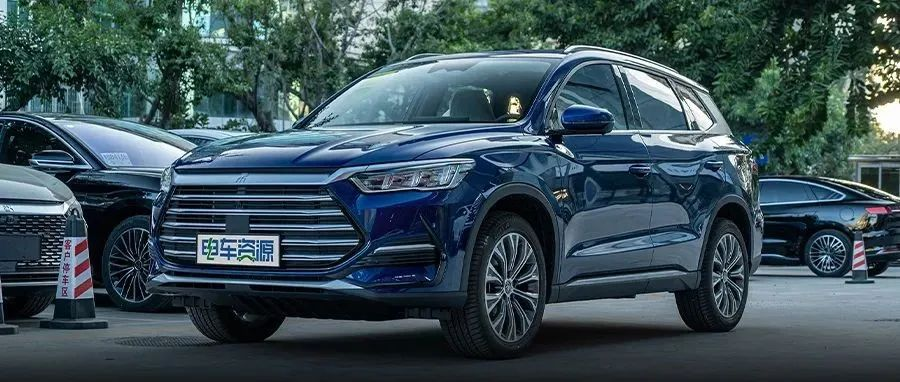Song Pro DM-i officially launched with five models priced between RMB 134,800 and RMB 159,800, a decrease of RMB 1,000-3,000 from the presale price.
The new car is a derivative upgrade of the second generation of Song Pro with the main changes in the power system. The car is equipped with Byd DM-i super hybrid system, featuring a 7.9-second acceleration, a 4.4L/100km plug-in hybrid fuel consumption, and a comprehensive range of 1090km, consistent with the Song PLUS DM-i.
Highlights
-
It features Dragon Face3.0 family-style design, which adds 19-inch double fork lightning sports wheels and launches an exclusive body color in sky blue;
-
The body size is consistent with the second generation of Song Pro, with the length, width, and height of 4650/1860/1700 mm and a wheelbase of 2712 mm;
-
The interior is upgraded with an 8.8-inch full LCD instrument panel and a 15.6-inch adaptive rotating large screen, as well as a new interior color scheme of Khaki + Ash Grey;
-
It features Byd DM-i super hybrid system.
Model Review
The new car took on the Dragon Face3.0 family design language and raised the opening ratio of the air intake grille from 60% to 75%, showing a stronger visual impact. In addition, there are more chrome-plated decorative strips, and the two lower fog light areas have also been further optimized with delicate details.
The side of the car remains consistent with the second generation of Song Pro, including body size and line design. Moreover, the top matching version has added 19-inch wheels with a brand-new double-fork lightning wheel hub design, which improves its sportiness.
The rear of the car has no significant changes except for DM-i lettering added at the bottom left corner. The through-type tail light and the light chamber integrating the “dragon claws” style are still retained.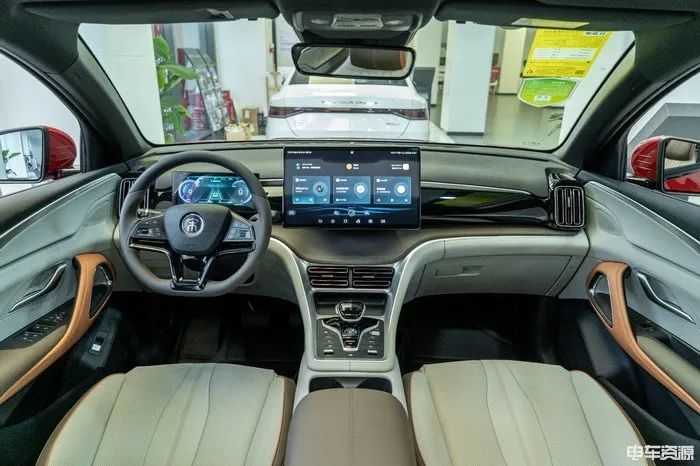
The interior design of the car is also very familiar, with the same layout and design as the second-generation Song Pro, but the size of the LCD instrument panel and central control screen has clearly increased. The size of the LCD instrument panel has been upgraded to 8.8 inches, while the central control screen is available in three sizes depending on the different models: 10.1/12.8/15.6 inches. The new car is equipped with the DiLink 4.0 (4G) intelligent network system across the board, and OTA remote upgrade is standard.
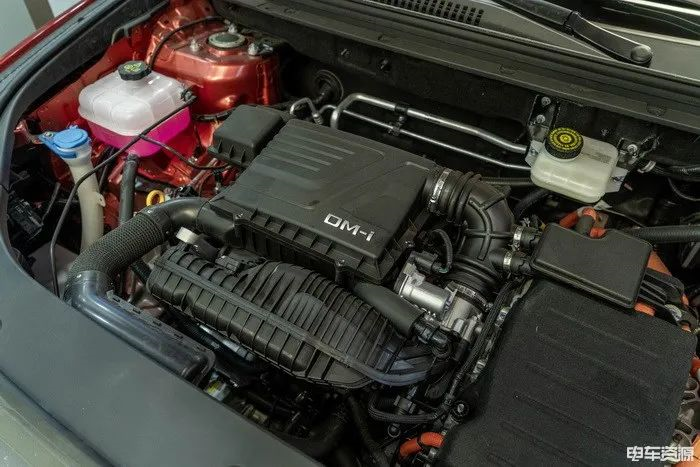
In terms of power, the new car is equipped with a 1.5L Atkinson cycle engine for plug-in hybrids from Shao Yun, with a maximum thermal efficiency of 43%. The maximum power of the engine is 81 kW, and the peak torque is 135 N·m. The 0-100 km/h acceleration time is only 7.9 seconds. In terms of pure electric endurance, the new car still offers two endurance versions of 51 km and 110 km respectively. Official data shows that the new car consumes 4.4L of electricity per hundred kilometers, and the maximum endurance under full fuel and electricity is 1090 km.
Configuration comparison
Endurance and power
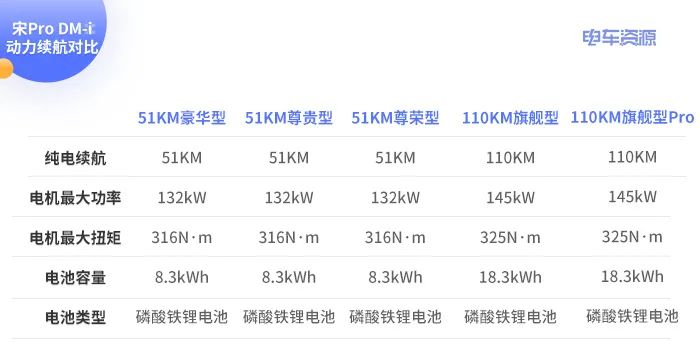
The Song Pro DM-i still offers two endurance versions of 51 km and 110 km respectively. The 51 km version offers three models with an 8.3 kWh battery capacity, while the 110 km version offers two models with an 18.3 kWh battery capacity. In terms of power performance, the maximum power of the motor in the 51 km version is 132 kW, and the maximum torque is 316 N·m; the maximum power of the motor in the 110 km version is 145 kW, and the maximum torque is 325 N·m.
External configuration differences
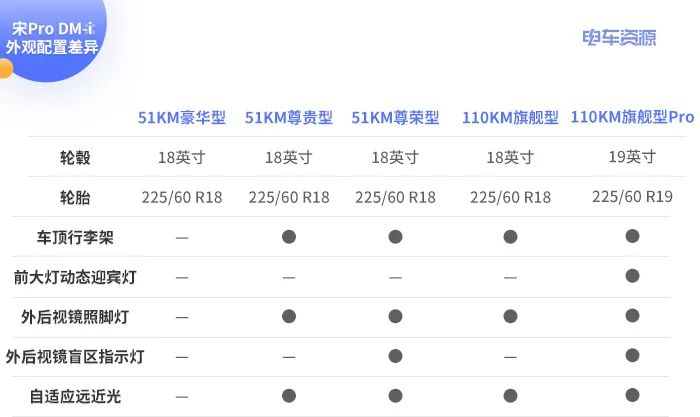
As for the differences of the Song Pro DM-i, it has been mentioned above in this article. The biggest difference among the 5 models is the flagship Pro of the 110 km endurance version, which is equipped with 19-inch wheels, while other models all have 18-inch wheels.#
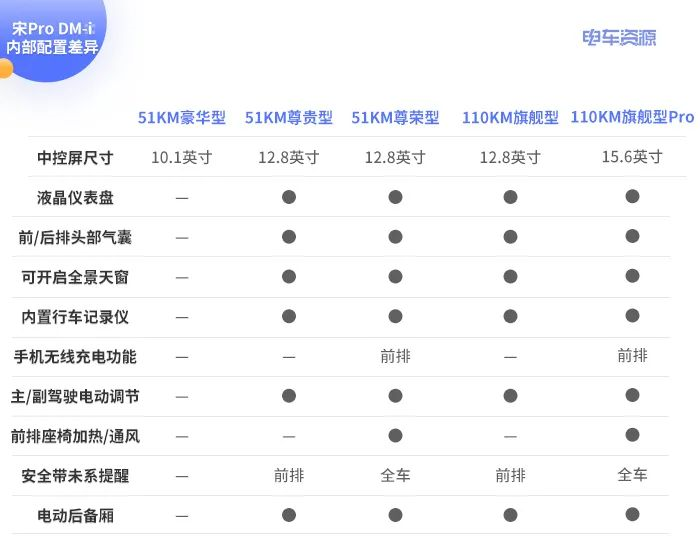
Differences in Interior Configuration

The differences in interior configurations can be said to be the greatest difference among the 5 models. Firstly, there are different screen sizes for the central control screen for different models, with 10.1/12.8/15.6 inches provided. The lowest configuration model, the 51 KM Premium version, naturally has a size of 10.1 inches, while the highest configuration model, the 110 KM flagship version Pro, has a size of 15.6 inches, and the other three middle models all have a uniform size of 12.8 inches.
Secondly, the lowest configuration model can be said to be the most “out-of-group” member. It does not have features such as LCD dashboard, front/rear head airbags, sunroof, built-in driving recorder, wireless charging for mobile phones, electric adjustment of driver/co-driver seats, front seat heating and ventilation, and electric tailgate.
The models with the most similar interior configurations are the 51 KM Luxury version and the 110 KM flagship version, with one being a low-end model with better endurance and the other being a high-end model with lower endurance. Their configurations are very similar. Features such as reminder for seat belt not fastened, LCD dashboard, front row wireless charging for mobile phones, and front seat heating and ventilation, which are only available on top configuration models, are also absent in both models. So the ten-thousand-yuan difference between the two models only leaves room for choosing power performance.
As for the 51 KM Honor version and the 110 KM flagship version Pro, although there is a difference of 11,000 yuan between them, perhaps because they are both top configuration models in terms of power and endurance, their status difference is not much. The difference of 11,000 yuan mainly lies in the difference in the size of the central control screen and the difference in power performance. Other aspects are consistent.
Differences in Driving Assistance
 The content of this section only applies to the base 51 KM Luxury model. Essentially, the differences in the driving assistance features between this car and the rest of the models are not significant. However, it’s worth noting that the base model still has a rearview camera, adaptive cruise control, automatic parking, and hill-start assist. There are only minor differences between the other four models, except for the two top-of-the-line models, which add lane departure warning systems and rear cross-traffic alert systems.
The content of this section only applies to the base 51 KM Luxury model. Essentially, the differences in the driving assistance features between this car and the rest of the models are not significant. However, it’s worth noting that the base model still has a rearview camera, adaptive cruise control, automatic parking, and hill-start assist. There are only minor differences between the other four models, except for the two top-of-the-line models, which add lane departure warning systems and rear cross-traffic alert systems.
Brief Review of Song Pro DM-i Models
51 KM Luxury Model
Recommendation Rating: ★★★★
As mentioned before, this model is similar to its position, and its basic configuration is not bad. At the same time, the price of 134,800 yuan is very attractive for an SUV with low fuel consumption, stylish interior and exterior design, and sufficient space for everyday family use. Although the base model lacks front/rear head airbags and a sunroof, it seems “shabby” compared to the 51 KM Prestige model. However, the 7,000 yuan price difference only improves the cost-effectiveness of the base model. Therefore, if you only need a car for daily commuting or family use, and you’re not too concerned about vehicle configuration and driver assistance, then this base model is the best choice.
51 KM Prestige Model
Recommendation Rating: ★★★
Without a doubt, if you only care about the base model being too “shabby” and don’t want to spend too much money, then this model is your only choice. Comparatively speaking, the 7,000 yuan price increase adds front/rear head airbags, a sunroof, and multiple driver assistance functions.
51 KM Prestige Model
Recommendation Rating: ★★★★★
This model can be understood as the top-of-the-line model for the 51 KM version. It basically has everything the Song Pro DM-i car has, except for the central control screen size and power performance differences compared to the 110 KM flagship Pro model. Therefore, if you don’t have any special requirements for electric range or power performance, this model has the best cost-effectiveness among the Song Pro DM-i models. The 12.8-inch central control screen is the same size as in most BYD models, so it won’t seem too small.
110 KM Flagship Model / 110 KM Flagship Pro Model
The front configuration of these two models has been discussed in detail. They are essentially the same as the 51 KM Prestige and 51 KM Prestige models, respectively, with improvements in pure electric range and power performance. As for the recommendation rating of these two models, refer to the previous two models of the 51 KM version.
Summary
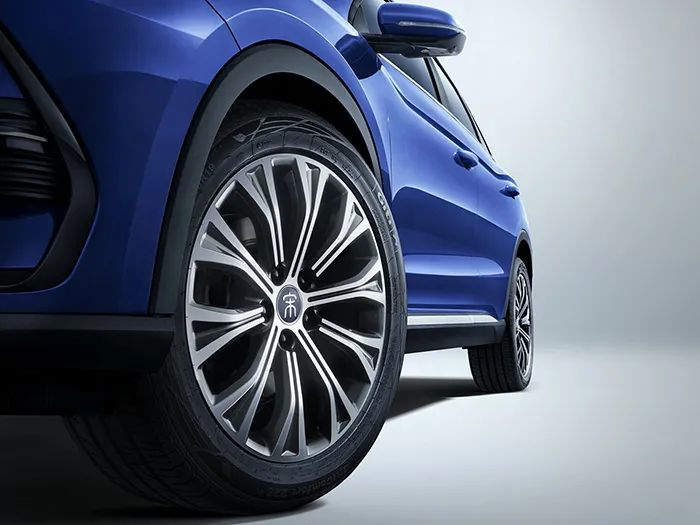 When it comes to choosing from the five models of the Song Pro DM-i, it’s not difficult to choose, as each corresponds to the car buyer’s needs.
When it comes to choosing from the five models of the Song Pro DM-i, it’s not difficult to choose, as each corresponds to the car buyer’s needs.
Overall, for consumers who only consider cost-effectiveness and don’t require high configurations, the 51KM Luxury version is the way to go. Conversely, if you require car configurations and auxiliary driving, it is recommended to go straight for the 51KM Honor version. As for the 110KM version, you should choose it based on your personal needs and budget.
Of course, no matter which model you choose, the Song Pro DM-i retains the driving habits of a traditional fuel-based car while enjoying the acceleration pleasure of an electric car, and no longer being restricted by a short range. The most important point is that the 134,800 to 159,800 yuan price range has had a significant impact on pure electric and traditional fuel-based cars in the same price range.
This article is a translation by ChatGPT of a Chinese report from 42HOW. If you have any questions about it, please email bd@42how.com.
